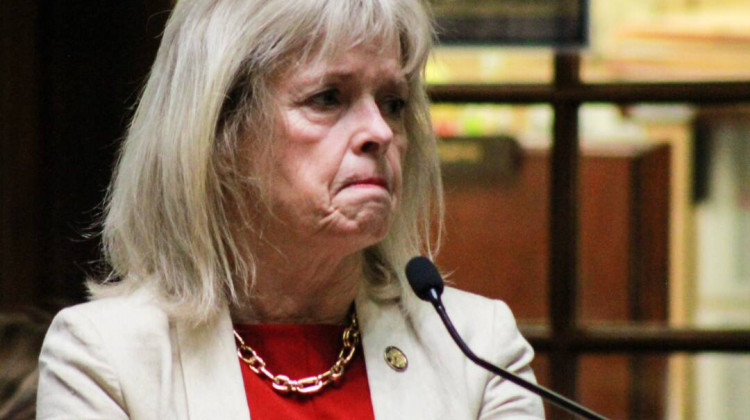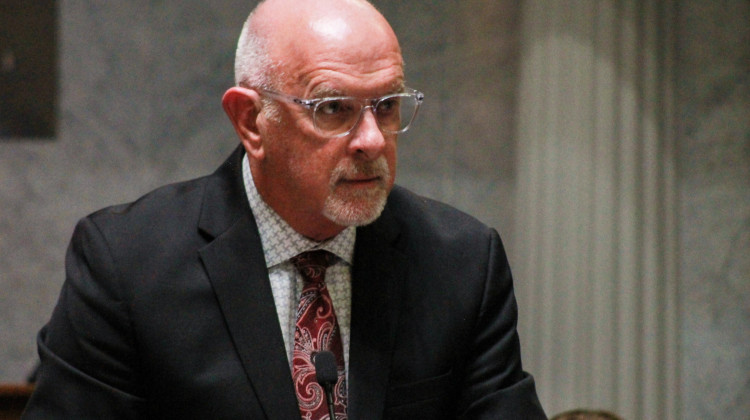
Franklin residents talk with officials at the Environmental Protection Agency about pollution coming from the Hougland Tomato Cannery at an open house in 2020. Residents suspect pollution from the cannery site as well as from the old Amphenol site could have cause rare child cancers in the area.
Rebecca Thiele/IPB NewsAdvocates for kids in Franklin with rare cancers have waited about six years for new federal guidelines for identifying cancer clusters. That’s when Trevor’s Law passed — a law meant to help investigate cancers caused by environmental pollution.
Now that those guidelines are finally here — advocates say the guidelines are better, but they’re a little disappointed.
The new guidelines by the Centers for Disease Control and Prevention recognize that not every person who gets exposed to one cancer-causing chemical — or multiple — will get the same type of cancer. They could get cancers that are linked in some way.
But Chris Nidel, an environmental attorney who represents some Franklin residents, said that’s pretty vague. And it puts a lot of the responsibility on state and local health departments to interpret it — many of which may not have the resources or the expertise.
“I don't see how they're not going to just end up saying, ‘Well, we see more than one type of cancer. So it's not a cluster.’ And that’s been the answer for the last 30 years," Nidel said.
The guidance also encourages health departments to investigate cancer clusters even without statistics to prove it. But Nidel said it still gives states the ability to dismiss residents’ concerns if those stats aren’t there.
Patrick Breysse directs the National Center for Environmental Health at the CDC as well as the Agency for Toxic Substances and Disease Registry. He said health departments can always reach out to the CDC for help — and the agency hopes to develop new tools and resources for them in the future.
“So we want to make sure as much as we can, the local state health departments have access to whatever expert guidance they need to address these issues going forward, especially if they may not have them on their own," Breysse said.
Local health departments are often underfunded and have few resources. Breysse said the CDC is aware of this and doing what it can to address that as well.
READ MORE: How polluted is my home or neighborhood? Here's how to find out
Join the conversation and sign up for the Indiana Two-Way. Text "Indiana" to 73224. Your comments and questions in response to our weekly text help us find the answers you need on statewide issues, including this series on climate change and solutions.
Nidel said ultimately it’s easier for state and local governments to prevent exposure to cancer-causing chemicals rather than try to find clusters.
“Clusters are just hard to identify. We don't have good data. We have people moving around. We have privacy issues. But we've got a bunch of Superfund sites," he said.
Superfunds are what the Environmental Protection Agency calls some of the most polluted sites in the country. There are more than 50 Superfund sites in Indiana that are on the EPA's National Priorities List— including U.S.S. Lead in East Chicago and the PCE plume in Martinsville.
Nidel and Kari Rhinehart of the Franklin group If It Was Your Child met with the EPA and other federal agencies in September. They joined other groups in a protest asking the EPA to update limits for toxic chemicals and fund scientific investigations free from industry’s influence.
CORRECTION: A previous version of this story said the Amphenol site is a Superfund on the EPA’s National Priorities List. That was incorrect. The cleanup is overseen by the EPA’s Resource Conservation and Recovery Act (RCRA) program, not Superfund.
Contact reporter Rebecca Thiele at rthiele@iu.edu or follow her on Twitter at @beckythiele.
 DONATE
DONATE






 Support WFYI. We can't do it without you.
Support WFYI. We can't do it without you.